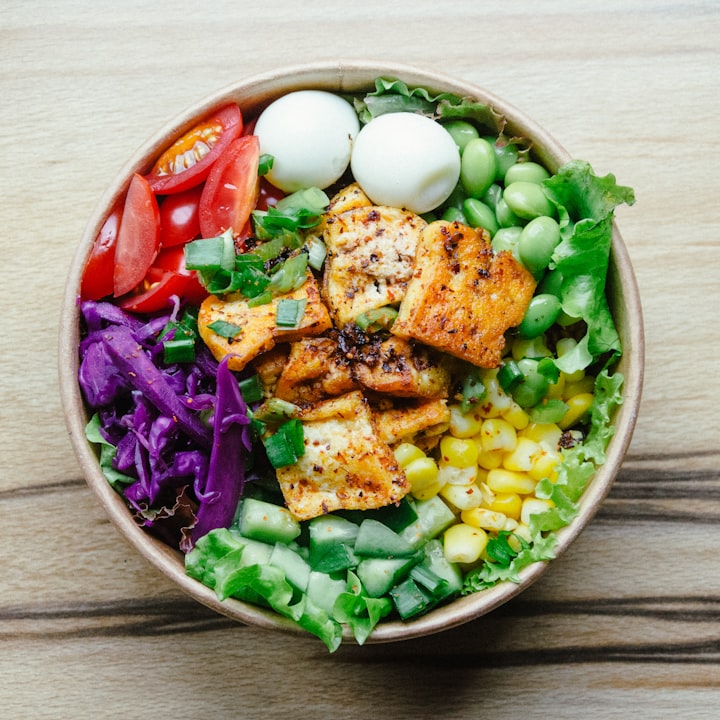Nutrition

Nutrition is a science of the growth, maintenance, health, reproduction, and diseases of an organism from nutrients in food. Food enables the body to make energy, build and maintain tissue, and regulate bodily processes. Each person has individual nutrition needs. Bodyweight and activity level determine how many calories a person uses for energy. Measurements such as TDEE ( total daily energy expenditure) and BMI (body mass index) are good basic standards to judge a person's overall health. A BMI of 18.55-24.9 is considered healthy. Certain things such as muscle mass have to be considered with these measurements.
Macronutrients are carbohydrates, proteins and fats. There are two types of carbohydrates, simple and complex. Complex carbohydrates are called polysaccharides. Complex carbohydrates contain fiber such as beans, legumes and grains. Simple carbohydrates are called monosaccharides or disaccharides. The criticism of carbohydrates mostly refers to simple carbohydrates. Protein. Twenty different amino acids join in various combinations to make all types of protein. Complete proteins provide all essential amino acids. Some proteins are complimentary, two or more together provide an adequate amount of essential amino acids. Proteins build body tissue. Fats are a collection of molecules called triglycerides. They are essential for growth and cell function. Three types of fat are saturated, unsaturated, and transfats.
Vitamins Fat soluble vitamins get stored in the body for days or months. Vitamins A, D, E and K are fat soluble. Vitamin A regulates the immune system, is important for bone and tooth development and is essential for light sensing cells in eyes. Vitamin A deficiency is the leading cause of preventable blindness in children. Vitamin D regulates the absorption of calcium and phosphorus for normal development of bones and teeth. The best source of vitamin D is the sun. Sun exposure causes the skin to produce vitamin d3, calciferol. Calciferol is sent to the liver where it is converted to calcifediol. Then it is converted to calcitriol, an active form of vitamin D in the body. Vitamin D deficiency can lead to weak bones in children. Rickets is a failure of bone tissue to become properly mineralized leading to soft bones and skeletal deformities. Vitamin E is a blood thinner and antioxidant. It prevents oxidative stress and protects fatty acids in cell membranes from free radicals. Vitamin K is essential for blood clotting and it supports bone health. It can interfere with blood thinners such as Coumadin. Water soluble vitamins do not get stored in the body. B vitamins and vitamin C are water soluble. A deficiency of vitamin B1 can cause the disease Beri Beri which impairs sensory and motor functions and reflexes. Vitamin B2 is also called riboflavin. Vitamin B boosts energy and protects skin and eye health. A deficiency in vitamin B2 can cause fatigue slow metabolism and nerve damage. Vitamin B3 is also known as niacin. A deficiency in B3 is rare and can cause a skin rash and dementia. Vitamin B5 is also called pantothenic acid. A deficiency of vitamin B5 is rare. Vitamin B6 is also known as pyridoxine. Vitamin B6 makes antibodies that help fight various diseases. A deficiency of vitamin B6 is rare. Vitamin C is a good antioxidant.
Essential minerals include magnesium, phosphorus, potassium, sodium, copper, iron and zinc. Magnesium is necessary for protein synthesis in the body. It is also necessary for muscle and nerve function, blood glucose control, blood pressure regulation and energy. A deficiency of magnesium is common so it is a good idea to check with a doctor. Phosphorus is necessary for tissue growth. Potassium is necessary for muscle contraction, nerve impulses, protein synthesis, the transfer of nutrients through cell membranes, breaking down carbohydrates and maintaining heart rhythm. Potassium is lost a lot through sweat and supplements can solve this problem. Sodium is necessary for nerve signaling, muscle control, fluid balance, the transfer of nutrients through cell membranes. Good sources of sodium are table salt, meat, fish, cheese , pickles, and salted nuts. It is more important to prevent an overdose of sodium than an under dose. Copper is necessary for the production and function of red blood cells, maintaining nerves and maintaining the immune system. Copper is found in oysters, other shellfish, dark leafy greens, pepper, liver, nuts and beans. Copper can be toxic. Iron is essential for energy for daily activity. Iron is lost through shedding intestinal cells, sweat and blood loss. Iron is found in chicken, grains, vegetables and nuts. Women require more iron than men. Zinc is necessary for the immune system, cell division, wound healing, the breakdown of carbohydrates, senses of smell and taste. Zinc can be found in beef, poultry, oysters, peas, beans, nuts, oatmeal and dairy. It is recommended to take a supplement if you have a weak immune system or often get colds.
Many diets have gained popularity. The paleo diet is a way of eating like our hunter gatherer ancestors. The vegan diet avoids all animal products and byproducts. The keto diet is a high fat low carbohydrate diet. There are advantages and disadvantages to each. For example, people with sensitivity to sugar will benefit from a low carbohydrate diet. The paleo diet excludes some very healthy foods. Any diet that completely avoids groups of foods completely is not necessary. Studies have not shown significant changes in muscle mass or fat loss compared to a normal diet.
When buying food, there are a few things to identify from the label. First check the list of ingredients, the fewer the better. Second, start at the top of a label and check the serving size. Third, check total calories. Fourth, check fat content looking for mostly unsaturated fat. Fifth, check cholesterol and sodium. Sixth, check carbohydrates looking for high fiber content and low sugar. Seventh, check protein. High protein content is best. Eighth, check vitamin content, the more vitamins the better. Fresh and frozen vegetables or fruit are similar. Fresh fruits and vegetables are usually picked before ripe and cannot develop a full range of nutrients. Frozen fruits and vegetables are picked at their peak and then boiled to kill bacteria. Boiling also kills vitamins. It is best if you can buy fruits and vegetable in season, just picked by a a farm.
In conclusion, for adequate nutrition eat the right amount of quality sources of protein, carbohydrates and fats. Choose healthy foods that you like the best. Eat right for your lifestyle and adjust your eating habits for any changes in activity level. Before starting a new diet or exercise regiment, ask a doctor for advice. Sometimes supplements are necessary but check with your doctor. Strive for a balance of nutrients for energy and health.






Comments
There are no comments for this story
Be the first to respond and start the conversation.